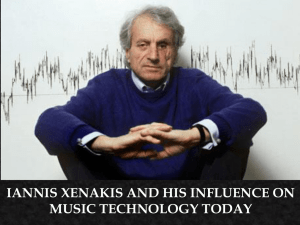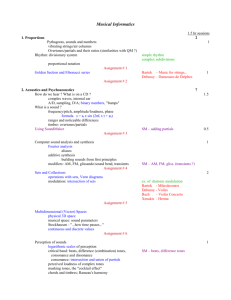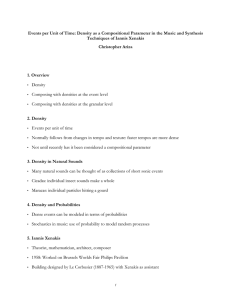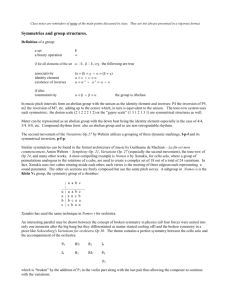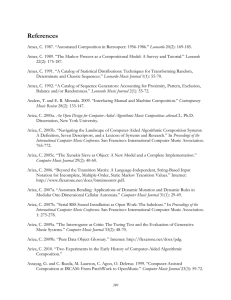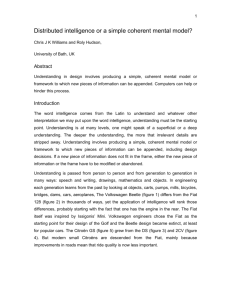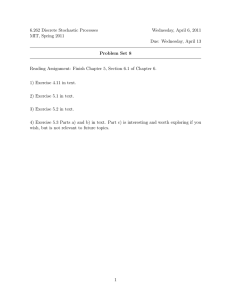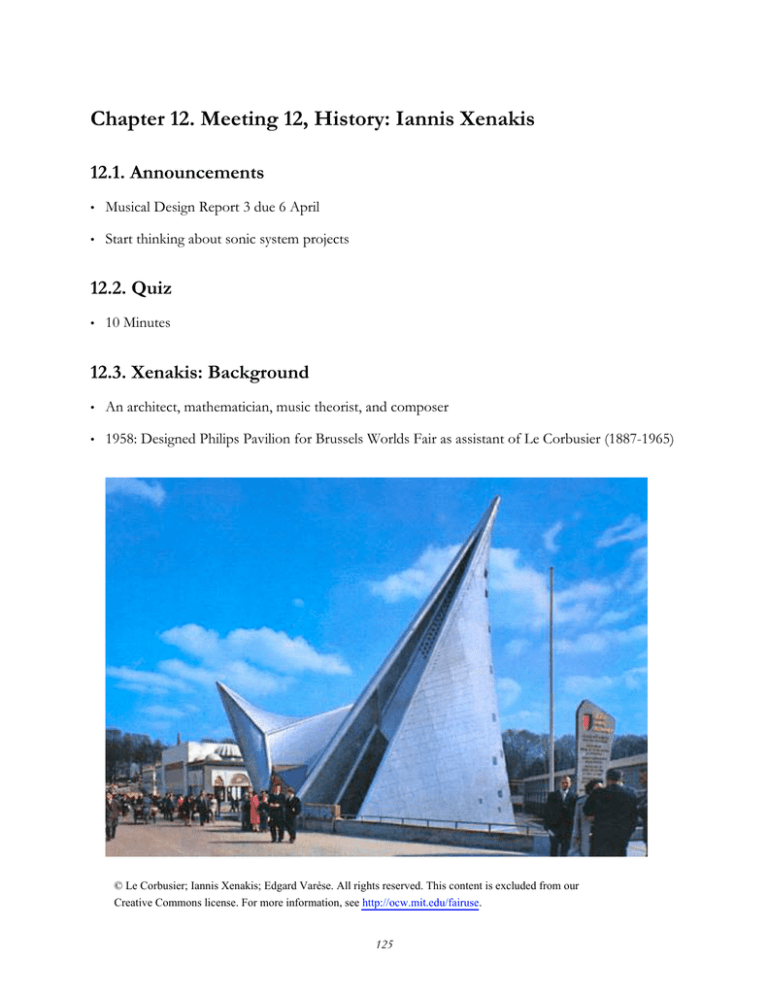
Chapter 12. Meeting 12, History: Iannis Xenakis
12.1. Announcements
•
Musical Design Report 3 due 6 April
•
Start thinking about sonic system projects
12.2. Quiz
•
10 Minutes
12.3. Xenakis: Background
•
An architect, mathematician, music theorist, and composer
•
1958: Designed Philips Pavilion for Brussels Worlds Fair as assistant of Le Corbusier (1887-1965)
© Le Corbusier; Iannis Xenakis; Edgard Varèse. All rights reserved. This content is excluded from our
Creative Commons license. For more information, see http://ocw.mit.edu/fairuse.
125
© Iannis Xenakis. All rights reserved. This content is excluded from our Creative
Commons license. For more information, see http://ocw.mit.edu/fairuse.
•
Early tape music: Diamorphoses (1957), Concret PH (1958), Orient Occident (1960)
•
Innovative early instrumental music based on geometries and procedures
126
Courtesy of Pendragon Press. Used with permission.
•
Proposed models of granular synthesis after research of Gabor
•
Proposed and developed a wide range of music technologies for creative applications
12.4. Xenakis: History
•
Fought in Greek resistance to Nazi occupation during World War II
•
Moved to France, began work with Le Corbusier, heard music of Schaeffer
•
Studied composition with Olivier Messiaen
•
1955: “The Crisis of Serial Music” (Xenakis 1955)
•
1963: first edition of text Formalized Music
•
1967-1972: professor at Indiana University, Bloomington
•
1972: creates the Centre d'Etudes de Mathematiques et Automatiques Musicale (CEMAMu) near
Paris
•
1972-1989: professor at Sorbonne University in Paris
127
12.5. Xenakis: Pithoprakta and Achorripsis
•
Pithoprakta (1955-56) and Achorripsis (1956-57): composed with systems based on probability and
statistics
•
Employed techniques of “stochastic music”: specify statistical trends, densities, and ranges rather
then all note parameters
•
A procedural approach to composition
•
A response to the “Crisis of Serialism” (Xenakis 1955)
•
“But other paths also led to the same stochastic crossroads -- first of all, natural events such as
the collision of hail or rain with hard surfaces, or the song of cicadas in a summer field. These
sonic events are made out of thousands of isolated sounds; this multitude of sounds, seen as a
totality, is a new sonic event. This mass event is articulated and forms a plastic mold of time,
which itself follows aleatory and stochastic laws.” (Xenakis 1992, p. 9)
12.6. Listening: Xenakis
•
Achorripsis, (1956-1957) [4:50 to 6:41]
12.7. Reading: Xenaxis, Xenakis on Xenakis
•
Xenakis, I. 1987. “Xenakis on Xenakis.” Perspectives of New Music 25(1-2): 16-63.
•
What was Xenakis’s early background in music and sound?
•
Throughout his writings Xenakis talks about the pressures and problems of the Conservatory,
Instruments, and Solfege: what is he referring to?
•
Xenakis has particular relationship with the visual, graphical, and drawn approaches to thinking
about music. Explain this relationship.
•
In what ways does Xenakis imagine that technology will change the role of music in people’s
lives?
128
12.8. The Stochastic Music Program
•
1961: Xenakis gains access to an IBM 7090 at IBM France
Courtesy of IBM Corporate Archives. Used with permission.
•
Programs the Stochastic Music Program (SMP) based on techniques used for Achorripsis
•
System produces “score tables” that are transcribed into Western notation
129
Source: Xenakis (1971). © Scott Foresman/Pearson. All rights reserved. This content is
excluded from our Creative Commons license. For more information, see http://ocw.mit.edu/fairuse.
•
1962: ST/10-1, 080262 (1956-1962) was premiered at IBM France
•
Numerous related ST compositions were created
•
1965: Complete program, in Fortran, published and distributed (Xenakis 1965)
12.9. The Stochastic Music Program and Density
•
Employed density as a compositional parameter at many levels
•
Method
1. Duration of each movement is determined
2. The mean density of notes during a movement is calculated (in events per unit of time)
130
3. Percentage of events given to each timbre class is determined
Source: Xenakis (1971). © Scott Foresman/Pearson. All rights reserved. This content is excluded
from our Creative Commons license. For more information, see http://ocw.mit.edu/fairuse.
4. For each event, the starting time point within the movement is calculated
5. From previously selected timbre classes, an instrument is chosen
6. A random chromatic pitch is chosen (as a shift of the instrument’s previous note)
7. The duration of the note is determined based on an instrument-specific mean
8. The events dynamic contour is selected form a list of 44 options
131
Source: Xenakis (1971). © Scott Foresman/Pearson. All rights reserved. This content is excluded
from our Creative Commons license. For more information, see http://ocw.mit.edu/fairuse.
12.10. Listening: Xenakis
•
Xenakis, ST-10, 1962
•
Xenakis, Atrées, 1960
132
•
Xenakis, ST-48, 1967
•
Xenakis, ST-4
12.11. Reading: Xenaxis, Free Stochastic Music
•
Xenakis, I. 1971. “Free stochastic Music.” In Cybernetics, art and ideas. J. Reichardt, ed. Greenwich:
New York Graphic Society. 124-142.
•
Numerous publications include related/identical material
•
Xenakis, I. 1965. “Free Stochastic Music from the Computer. Programme of Stochastic music
in Fortran.” Gravesaner Blätter 26.
•
Xenakis, I. 1992. Formalized Music: Thought and Mathematics in Music. Indiana: Indiana University
Press.
133
•
How does Xenakis describe the public reaction to the use of computers in music?
•
Xenakis describes mental mechanisms: are these just rules or mathematics?
•
Xenakis imagines two new roles for contemporary composers: what are they?
•
What are some of the advantages that Xenakis offers through the use of electronic brains?
12.12. Composing with Densities using TM TimeFill and a Noise
Instrument
•
TM LineGroove produces non-overlapping, linear events
•
TM TimeFill will fill a time region with events, where position within the time span is determined
by a ParameterObject
•
Total number of events is determined by a ParameterObject
•
Look at TM TimeSegment for a way to divide a texture into segments, each with independent fill
densities
•
Command sequence:
•
emo cn
•
tmo tf
•
tin a 80
•
tie t 0,30
•
total event count is defined as static texture parameter, not a ParameterObject
tie s3 600
•
start position within texture normalized within unit interval
tie d0 rb,.3,.3,0,1
•
durations are independent of start time
tie r cs,(mv,a{.01}b{1.5}c{3}:{a=20|b=1|c=1})
•
must reduce amplitudes
tie a ru,.5,.9
•
eln; elr; elh
134
12.13. Composing with Densities using TM TimeFill and a Single
Sample
•
Total number of events is determined by the combination of two ParameterObjects with
IterateCross
•
Command sequence:
•
emo cn
•
tmo tf
•
tin a 32
•
set a file path to an audio file
tie x6 cf,/Volumes/xdisc/_sync/_x/src/martingale/martingale/audio/27980-high-slow.aif
•
start position within audio file in seconds
tie x5 ru,0,1
•
vary a low pass filter start and end frequencies
tie x2 mv,a{200}b{1000}c{10000}:{a=6|b=2|c=1}
tie x3 mv,a{200}b{1000}c{10000}:{a=6|b=2|c=1}
•
total event count is defined as static texture parameter, not a ParameterObject
tie s3 500
•
start position within texture normalized within unit interval
tie d0 ic,(rg,.2,.1,0,1),(rg,.7,.1,0,1),(bg,rc,(0,1))
•
durations are independent of start time
tie r cs,(whps,e,(bg,rp,(5,10,15)),0,.010,.100)
•
must reduce amplitudes
tie a ru,.1,.3
•
eln; elr; elh
135
MIT OpenCourseWare
http://ocw.mit.edu
21M.380 Music and Technology: Algorithmic and Generative Music
Spring 2010
For information about citing these materials or our Terms of Use, visit: http://ocw.mit.edu/terms.

